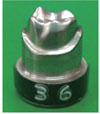1. Al-Abidi K, Ellakwa A. The effect of adding a stone base on the accuracy of working casts using different types of dental stone. J Contemp Dent Pract. 2006; 7:17–28.
2. Anusavice KJ. Phillip's science of dental material. 11th ed. Philadelphia: WB Saunders;2003. p. 621–654.
3. ISO 6873. Dental gypsum products. International Organization for Standardization. 3rd ed. Geneva: Switzerland;2013.
5. Kim KB, Kim JH, Kim WC, Kim HY, Kim JH. Evaluation of the marginal and internal gap of metal-ceramic crown fabricated with a selective laser sintering technology: two- and three-dimensional replica techniques. J Adv Prosthodont. 2013; 5:179–186.
6. American Dental Association. Specification No. 25 for dental gypsum products. Certification program for dental materials. Chicago: American Dental Association;1990. p. 1–14.
7. Millstein PL. Determining the accuracy of gypsum casts made from type IV dental stone. J Oral Rehabil. 1992; 19:239–243.
8. Duke P, Moore BK, Haug SP, Andres CJ. Study of the physical properties of type IV gypsum, resin-containing, and epoxy die materials. J Prosthet Dent. 2000; 83:466–473.
9. Kim JH, Kim KB, Kim WC, Kim JH, Kim HY. Accuracy and precision of polyurethane dental arch models fabricated using a three-dimensional subtractive rapid prototyping method with an intraoral scanning technique. Korean J Orthod. 2014; 44:69–76.
10. Linke BA, Nicholls JI, Faucher RR. Distortion analysis of stone casts made from impression materials. J Prosthet Dent. 1985; 54:794–802.
11. DeLong R, Pintado MR, Ko CC, Hodges JS, Douglas WH. Factors influencing optical 3D scanning of vinyl polysiloxane impression materials. J Prosthodont. 2001; 10:78–85.
12. Rodriguez JM, Curtis RV, Bartlett DW. Surface roughness of impression materials and dental stones scanned by non-contacting laser profilometry. Dent Mater. 2009; 25:500–505.
13. Beuer F, Aggstaller H, Edelhoff D, Gernet W, Sorensen J. Marginal and internal fits of fixed dental prostheses zirconia retainers. Dent Mater. 2009; 25:94–102.
14. Kokubo Y, Nagayama Y, Tsumita M, Ohkubo C, Fukushima S, Vult von Steyern P. Clinical marginal and internal gaps of In-Ceram crowns fabricated using the GN-I system. J Oral Rehabil. 2005; 32:753–758.
15. Williams GJ, Wild S, Bates JF. A study of some factors affecting the surface properties of dental stone. Br Dent J. 1984; 156:46–53.
16. Keuter FM, Davidson CL. Surface roughness of dental stone casts from alginate impressions. J Dent. 1986; 14:23–28.
17. Nanami T, Ostlund SG. Surface texture of stone model setting against elastomer impression materials. Swed Dent J. 1984; 8:251–255.
18. Ender A, Mehl A. Influence of scanning strategies on the accuracy of digital intraoral scanning systems. Int J Comput Dent. 2013; 16:11–21.
19. Karl M, Graef F, Schubinski P, Taylor T. Effect of intraoral scanning on the passivity of fit of implant-supported fixed dental prostheses. Quintessence Int. 2012; 43:555–562.
20. Luthardt RG, Sandkuhl O, Herold V, Walter MH. Accuracy of mechanical digitizing with a CAD/CAM system for fixed restorations. Int J Prosthodont. 2001; 14:146–151.
21. Reports of councils and bureaus: Revised American National Standards Institute/American Dental Association Specification No. 8 for zinc phosphate cement. J Am Dent Assoc. 1978; 96:121–123.
22. Sorensen SE, Larsen IB, Jörgensen KD. Gingival and alveolar bone reaction to marginal fit of subgingival crown margins. Scand J Dent Res. 1986; 94:109–114.
23. McLean JW, von Fraunhofer JA. The estimation of cement film thickness by an in vivo technique. Br Dent J. 1971; 131:107–111.
24. Jorgensen KD, Esbensen AL. The relationship between the film thickness of zinc phosphate cement and the retention of veneer crowns. Acta Odontol Scand. 1968; 26:169–175.
25. Passon C, Lambert RH, Lambert RL, Newman S. The effect of multiple layers of die-spacer on crown retention. Oper Dent. 1992; 17:42–49.
26. Persson AS, Andersson M, Odén A, Sandborgh-Englund G. Computer aided analysis of digitized dental stone replicas by dental CAD/CAM technology. Dent Mater. 2008; 24:1123–1130.









 PDF
PDF ePub
ePub Citation
Citation Print
Print






 XML Download
XML Download